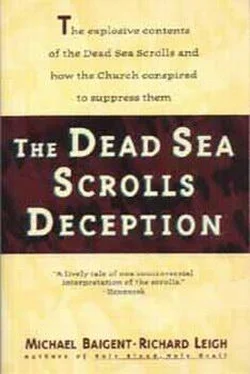The final ceasefire took effect on 7 January 1949. According to its terms, the large central section of what had formerly been Palestine was to remain Arab. This territory was occupied and then annexed by Transjordan, which on 2 June 1949 began to call itself simply Jordan. Thus Qumran passed into Jordanian hands, along with the Arab east side of Jerusalem. The border between Israel and Jordan — the Nablus road — cut through the centre of the city.
Amidst these dramatic historical events, the scrolls attracted little public attention or interest. Behind the scenes, however, political, religious and academic forces were already beginning to mobilise. By January 1949, the Department of Antiquities for Transjordan and Arab Palestine had become involved, under the auspices of its director, Gerald Lankester Harding. So had Father Roland de Vaux, director, since 1945, of another institution — the Dominican-sponsored Ecole Biblique, situated in the Jordanian-controlled eastern sector of Jerusalem, and for the last sixty years a centre of French-Catholic biblical scholarship in the city.
A year and a half had now elapsed since the scrolls were first found. To date, however, no trained archaeologist had visited the site of the discovery. The Albright Institute had tried, but the war, they decided, rendered any such endeavours too dangerous. It was at this point that a Belgian air-force officer, Captain Philippe Lippens, appeared on the scene. Lippens had arrived in Jerusalem as a member of the United Nations Truce Supervision Organisation. But he was also Jesuit-trained, and a graduate of the Oriental Institute at the University of Louvain. He had read of the scrolls, and now approached de Vaux, who until then appears to have been sceptical about their significance. If he managed to locate the cave of the original discovery, Lippens asked, would de Vaux confer legitimacy on the undertaking by acting as technical director for subsequent excavations? De Vaux assented.
On 24 January, Lippens established the support of a British officer commanding a brigade of the Jordanian Arab Legion, and, through this officer, the support of Lankester Harding in Amman. With Harding’s blessing, the British Army’s archaeological officer was despatched to Qumran, to search for the cave in which the original discovery had been made. He was accompanied by two Bedouin from the Arab Legion, who located the cave on 28 January. Inside, they found remains of the linen in which the scrolls had been wrapped and numerous pieces of pottery. A fortnight or so later, early in February, Harding and de Vaux visited the cave together. They found enough shards for more than forty jars and the remains of thirty identifiable texts, as well as many more unidentifiable fragments. Within another fortnight, the first official archaeological expedition had been mounted.
In the years that followed, scrolls became big business indeed, and traffic in them came to constitute an extremely lucrative cottage industry. Fragments were being smuggled to and fro in dirty wallets, in cigarette boxes, in assorted other makeshift containers. Forgeries began to appear, and wily local merchants had no shortage of gullible purchasers. The popular press portrayed anything resembling ancient parchment as immensely valuable. In consequence, Arab dealers were loath to settle for anything less than hundreds of pounds, and on at least one occasion a thousand — and this, it must be remembered, was in the days when a house could be mortgaged for £1500.
When Metropolitan Samuel took his scrolls to the United States, Jordanian radio reports claimed he was asking a million dollars for them. Fears arose that scrolls would be bought not only for private collections and as souvenirs, but also as investments. At the same time, of course, the scrolls themselves were dangerously fragile, requiring special conditions of light and temperature to preserve them from further deterioration. In many of them, indeed, the process of deterioration was already irreversible. As the black market burgeoned, so did the prospect of ever more valuable material being lost irretrievably to scholarship.
Responsibility to do something about the matter devolved upon Gerald Lankester Harding of the Department of Antiquities. Harding concluded it was less important to insist on the letter of the law than to rescue as many scrolls and fragments as he could. In consequence, he adopted a policy of purchasing scroll material from whomever happened to have it. This affected the legal status of such material by tacitly acknowledging that anyone who possessed it had a legitimate claim to it. In their negotiations and transactions, Harding’s agents were authorised to ignore all questions of legality and (up to a point) price. He himself, being fluent in Arabic, befriended not just dealers, but the Bedouin as well, and let it be known he would pay handsomely for anything they might obtain. Nevertheless, Metropolitan Samuel was accused of having ‘smuggled’ his scrolls out of the country, and the Jordanian government demanded their return. By that time, of course, it was too late. Eventually, the Bedouin of the Ta’amireh tribe were given what amounted to a ‘cave-hunting monopoly’. The Qumran area became, in effect, a military zone, and the Ta’amireh were charged with policing it, ‘to keep other tribes from muscling in on the scroll rush’. 10Whatever the Ta’amireh found, they would take to Kando, who would remunerate them. Kando would take the material to Harding and be remunerated in turn.
In October 1951, members of the Ta’amireh tribe arrived in Jerusalem with scroll fragments from a new site. Both Father de Vaux of the Ecole Biblique and Harding were away, so the Bedouin approached Joseph Saad, director of the Rockefeller Museum. Saad demanded to be taken to the site in question. The Bedouin went off to consult, and failed to return.
Saad obtained a jeep, a letter of authority from the archaeological officer of the Arab Legion and some armed men and drove to the first Ta’amireh camp he could find, outside Bethlehem. The next morning, as he was driving into Bethlehem, he saw one of the men who had approached him the day before. Dispensing with all niceties, Saad proceeded to kidnap the Bedouin:
As the Jeep slewed to a stop, Saad called the man over and immediately demanded more information about the cave. Fear came into the Arab’s eyes and he made as if to move on. The soldiers leapt down from the jeep and barred his way. Then, at a nod from Saad they lifted the man bodily and pushed him into the back of the truck. The driver let in the clutch and they roared off back the way they had come. 11
Subjected to this sort of persuasion, the Bedouin agreed to cooperate. Saad obtained reinforcements from a nearby military post, and the contingent headed off down the Wadi Ta’amireh towards the Dead Sea. When the terrain became impassable, they abandoned the jeep and began to walk. They walked for seven hours, until they came to a wadi with walls hundreds of feet high. Far up in the cliff-face, two large caves could be seen, with clouds of dust issuing from them — the Bedouin were already inside, collecting what they could. At Saad’s arrival, a number of them emerged. The soldiers accompanying Saad fired into the air and the Bedouin dispersed. Of the two caves, one, when the soldiers reached it, proved to be huge — twenty feet wide, twelve to fifteen feet high and extending some 150 feet back into the cliff. It was the next morning before Saad got back to Jerusalem. Exhausted after his expedition (which had included fourteen hours of walking), he went to sleep. He woke later in the day to find Jerusalem in a state of upheaval. Friends of the Bedouin had spread the news of his ‘kidnapping’ and incarceration. One commentator observed afterwards that it was ‘perhaps’ a mistake to have used force: this served to drive documents underground and made the Bedouin more reluctant to relinquish what they found. 12
Читать дальше












